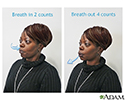How to breathe when you are short of breath
Pursed lip breathing; COPD - pursed lip breathing; Emphysema - pursed lip breathing; Chronic bronchitis - pursed lip breathing; Pulmonary fibrosis - pursed lip breathing; Interstitial lung disease - pursed lip breathing; Hypoxia - pursed lip breathing; Chronic respiratory failure - pursed lip breathing
When to use Pursed lip Breathing
Pursed lip breathing helps you use less energy to breathe. It can help you relax. When you are short of breath, it helps you slow the pace of your breathing and can help you feel less short of breath.
Use pursed lip breathing when you do things that make you short of breath, such as:
- Exercise
- Bend
- Lift
- Climb stairs
- Feel anxious
You can practice pursed lip breathing anytime. Try to practice 4 or 5 times a day when you:
- Watch TV
- Use your computer
- Read a newspaper
How to do Pursed lip Breathing
The steps to do pursed lip breathing are:
- Relax the muscles in your neck and shoulders.
- Sit in a comfortable chair with your feet on the floor.
- Inhale slowly through your nose for 2 counts.
- Feel your belly get larger as you breathe in.
- Pucker your lips, as if you were going to whistle or blow out a candle.
- Exhale slowly through your lips for 4 or more counts.
Exhale normally. DO NOT force the air out. DO NOT hold your breath when you are doing pursed lip breathing. Repeat these steps until your breathing slows.
References
Celli BR, Zuwallack RL. Pulmonary rehabilitation. In: Broaddus VC, Mason RJ, Ernst JD, et al, eds. Murray and Nadel's Textbook of Respiratory Medicine . 6th ed. Philadelphia, PA: Elsevier Saunders; 2016:chap 105.
Schwartzstein RM, Adams L. Dyspnea. In: Broaddus VC, Mason RJ, Ernst JD, et al, eds. Murray and Nadel's Textbook of Respiratory Medicine . 6th ed. Philadelphia, PA: Elsevier Saunders; 2016:chap 29.
-
Pursed lip breathing - illustration
How to do pursed lip breathing: Breath in (inhale) slowly through your nose for 2 counts.Feel your belly get larger as you breathe in.Pucker your lips, as if you were going to whistle or blow out a candle.Breathe out (exhale) slowly through your lips for 4 or more counts. Breath in (inhale) slowly through your nose for 2 counts. Feel your belly get larger as you breathe in. Pucker your lips, as if you were going to whistle or blow out a candle. Breathe out (exhale) slowly through your lips for 4 or more counts. Exhale normally. Do not force air out. Do not hold your breath when you are doing pursed lip breathing. Repeat these steps until your breathing slows.
Pursed lip breathing
illustration
-
Pursed lip breathing - illustration
How to do pursed lip breathing: Breath in (inhale) slowly through your nose for 2 counts.Feel your belly get larger as you breathe in.Pucker your lips, as if you were going to whistle or blow out a candle.Breathe out (exhale) slowly through your lips for 4 or more counts. Breath in (inhale) slowly through your nose for 2 counts. Feel your belly get larger as you breathe in. Pucker your lips, as if you were going to whistle or blow out a candle. Breathe out (exhale) slowly through your lips for 4 or more counts. Exhale normally. Do not force air out. Do not hold your breath when you are doing pursed lip breathing. Repeat these steps until your breathing slows.
Pursed lip breathing
illustration
Review Date: 2/2/2016
Reviewed By: Denis Hadjiliadis, MD, MHS, Associate Professor of Medicine, Pulmonary, Allergy, and Critical Care, Perelman School of Medicine, University of Pennsylvania, Philadelphia, PA. Also reviewed by David Zieve, MD, MHA, Isla Ogilvie, PhD, and the A.D.A.M. Editorial team.

